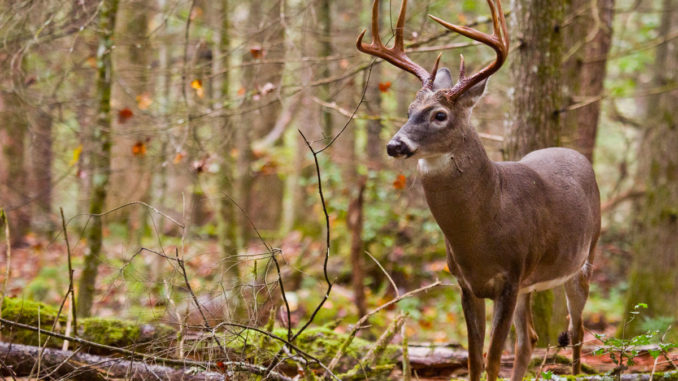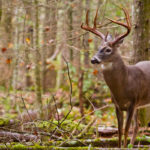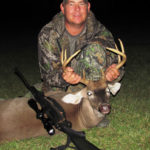
Think thick cover and new food sources when targeting South Carolina’s late-season deer.
As the end of the season approaches, hunting pressure has taken its toll on deer. Many have been killed and most of the rest educated to typical hunter strategies. Blend in cold and sometimes nasty weather, and hunting effort dwindles. Plus, small-game hunting enters the picture, and instead of having to sit still in the cold weather, small-game hunters typically can stay on the move and keep warm much easier.
But not all hunters give up on whitetails. Committed deer hunters know that the last month of the season can still produce plenty of venison for the freezer, as well as big antlers for the wall. They do admit that after the rut it become more difficult. Deer don’t move as much, and hunters cannot have the same high expectations of seeing deer, especially big bucks, as they do during the rut.
Late-season hunting can be successful for those with a good plan, but hunters must change their mindset and strategies. Based on antler-scoring data from the S.C. Department of Natural Resources, the post-rut produces some trophy bucks, more than the early season, and respectable numbers of deer, but patterns have changed, and hunters must change with them or they’ll be looking at woods and fields void of deer.
Chris Orvin from Moncks Corner is a fishing guide by profession but a deer hunter by desire. He has learned that December can be a good time for taking deer in the Lowcountry.
“First and foremost, when hunting deer in the post-rut, hunters have to forget where deer have been all season,” Orvin said. “Post-rut hunting can be more difficult because deer are moving to more dense areas, and some even become nocturnal. Deer patterns actually constantly change as the season progresses from early season to pre-rut to rut and then to post-rut. At each of these times, deer will have favored habitats and foods, and that’s where you have to hunt.
“In terms of hunting … the end of the season, many hunters get into a bad pattern of continuing to hunt where they saw and perhaps took deer during the rut,” he said. “But the simple fact is, the ongoing life patterns for deer have changed, and to be successful, so must deer hunters.
“The big bucks return to their highly suspicious and self-preservation mode, and the doe deer also get more wary. But hunters that adapt to the changes can be consistently successful. Deer typically move to the thicker, dense woods and swamps. This occurs as they change from their reproductive needs during the rut to more of a survival instinct late in the season.”
Orvin said that the deer have an Achilles heel in December, specifically their need to eat.
“One of the tough things for deer in late-season is less natural forage to eat once the acorns are gone,” Orvin said. “But that’s a good thing for hunters willing to work and put in some effort, because with a bit of effort, we can plant food plots with fresh greenery to draw them out.
“Deer do have a fondness for tender, leafy, green grub in cold weather, so that’s what we provide where I hunt. We determine the areas where they are staying and where the water sources are, and get a food plot — or several food plots — into their area. We plant a lot of the commercial blends, but also oats are very good individually, as are peas, beans, turnips and radishes. Most of the time the tops are eaten quickly after getting out of the ground, and I’ll often re-sow them, especially beans and peas, so they’ll be more available for the deer. I may do that two or three times if necessary, to keep fresh greenery in the area. But if you plant the green, succulent food sources for them, they will come to it — not just the does, but the bucks as well.”
Orvin also said that getting away from other hunters can be a key to success. It’s a tactic he uses when hunting on public lands, which he often does for turkeys as well.
“After a long season of being hunted, deer get a bit hunter-shy, to say the least,” Orvin said. “One key to success will be to get far from the remaining hunters as you can. Deer will usually tolerate less human interface during this time of the season than at any other. The use of vocalization can still be effective, but I think it must be done in moderation. It’s easy to overdo in rut, but a little — a single simple grunt or two — can often go a long way.”
Orvin believes hunting pressure is one of the reasons deer begin to get nocturnal by the late season, and it sometimes determines where he hunts as Christmas approaches.
“By being singular in your hunting effort, other hunters can push deer to you if you hunt deep in the woods,” he said. “If you locate a good travel route deep in the woods, and it’s near a bedding or food source, sometimes you can have other hunters hunting on the outskirts of the area push deer past you. You’ll need to get to your stand early, be still and quiet and be patient. But you may get the opportunity to bust a big buck slipping away from hunters working the perimeter of the area while you’re in the middle.”
Mike Johnson, general manager of the Clinton House near Clinton, enjoys the post-rut and said that with a little effort on a hunter’s part, deer can become somewhat predictable.
“I’ve developed some patterns for tracking the deer and keeping them in certain areas after the rut,” Johnson said. “The key here is to stay one step ahead of a big buck so our clients will have the opportunity to shoot. First, hunters need to understand what’s happening before they can try to cope with it.”
Johnson said that just as the rut is part of a deer’s survival instinct as a species and on a more personal level.
“The first thing I do is learn from previous seasons,” he said. “When the rut begins to slow — and that’s easy to figure out by a big decrease in deer movements in breeding areas — I get ahead of the situation using trial cameras. In fact, I try to get the trail cameras out in areas where I believe deer will be about two weeks ahead of time. That way I’ll know when they first get there.
“As soon as they begin showing up in a specific area, I really begin to key on those areas,” he said. “I try to ensure the bucks are not just passing though, and that’s where the cameras help so much. When deer are consistently showing up in areas previously void of deer, I know changes have taken place.
“There are other ways to do it, and one is simply to sit in stands to observe and not shoot. You can see a lot more than just what the camera will capture in a single location. This is a good tactic as a guide to learn about post-rut deer habits, especially once I know a nice buck is using an area. Then I can see if other bucks or does are out during shooting times as well. There areas can be food plots, but also the thick bottoms and along the heavy cover of creeks and branches.”
Johnson said a lot of the little things also add up to help success during the post rut.
“Being patient is something hunters often talk about, but it’s really more crucial now than at any other time of the year; it is a key to late-season success,” he said. “Also, prepare for the hunt by wearing the right clothing; you don’t want to be shivering and rubbing your hands to stay warm. Wear ample clothes, use the scentless hand warmers if it’s cold and pay close attention to the woods.
“The quick movements of bucks chasing does during the rut are gone. Most deer will be silent and slipping through. Plan your shots before you even see a deer. Look at the terrain you are hunting and pre-plan possible shooting lanes for as many scenarios as possible. If you see the deer soon after he’s in your field of vision, odds are good you will be able to get a high-percentage shot.”
Hunting late in the season, after the rut, can be rewarding and successful with the right effort and dedication. According to Orvin and Johnson, if you plan the hunt and work the plan, you can be successful in this often overlooked, but productive portion of the season.






Be the first to comment